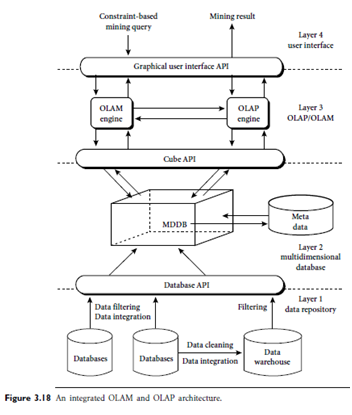On-line Analytical Processing To On-line Analytical Mining
Introduction: In the field of data mining, substantial research has been performed for data mining on various platforms, including transaction databases, relational databases, spatial databases, text databases, time-series databases, flat files, data warehouses, and so on.
On-line analytical mining (OLAM) (also called OLAP mining) integrates on-line analytical processing (OLAP) with data mining and mining knowledge in multidimensional databases. Among the many different paradigms and architectures of data mining systems, OLAM is particularly important for the following reasons:
High quality of data in data warehouses: Most data mining tools need to work on integrated, consistent, and cleaned data, which requires costly data cleaning, data integration and data transformation as preprocessing steps. A data warehouse constructed by such preprocessing serves as a valuable source of high quality data for OLAP as well as for data mining. Notice that data mining may also serve as a valuable tool for data cleaning and data integration as well.
Available information processing infrastructure surrounding data warehouses: Comprehensive information processing and data analysis infrastructures have been or will be systematically constructed surrounding data warehouses, which include accessing, integration, consolidation, and transformation of multiple heterogeneous databases, ODBC/OLE DB connections, Web-accessing and service facilities, and reporting and OLAP analysis tools. It is prudent to make the best use of the available infrastructures rather than constructing everything from scratch.
OLAP-based exploratory data analysis: Effective data mining needs exploratory data analysis. A user will often want to traverse through a database, select portions of relevant data, and analyze them at different granularities, and present knowledge / results in different forms. On-line analytical mining provides facilities for data mining on different subsets of data and at different levels of abstraction, by drilling, pivoting, filtering, dicing, and slicing on a data cube and on some intermediate data mining results. This, together with data/knowledge visualization tools, will greatly enhance the power and flexibility of exploratory data mining.

On-line selection of data mining functions: Often a user may not know what kinds of knowledge she would like to mine. By integrating OLAP with multiple data mining functions, on-line analytical mining provides users with the flexibility to select desired data mining functions and swap data mining tasks dynamically.
Architecture for On-Line Analytical Mining: An OLAM server performs analytical mining in data cubes in a similar manner as an OLAP server performs on-line analytical processing. An integrated OLAM and OLAP architecture is shown in Figure 3.18, where the OLAM and OLAP servers both accept user on-line queries (or commands) via a graphical user interface API and work with the data cube in the data analysis via a cube API. A metadata directory is used to guide the access of the data cube. The data cube can be constructed by accessing and/or integrating multiple databases via an MDDB API and/or by filtering a data warehouse via a database API that may support OLE DB or ODBC connections. Since an OLAM server may perform multiple data mining tasks, such as concept description, association, classification, prediction, clustering, time-series analysis, and so on, it usually consists of multiple integrated data mining modules and is more sophisticated than an OLAP server.
As we have seen, the introduction to data warehousing and OLAP technology presented in this chapter is essential to our study of data mining. This is because data warehousing provides users with large amounts of clean, organized, and summarized data, which greatly facilitates data mining. For example, rather than storing the details of each sales transaction, a data warehouse may store a summary of the transactions per item type for each branch or, summarized to a higher level, for each country. The capability of OLAP to provide multiple and dynamic views of summarized data in a data warehouse sets a solid foundation for successful data mining.